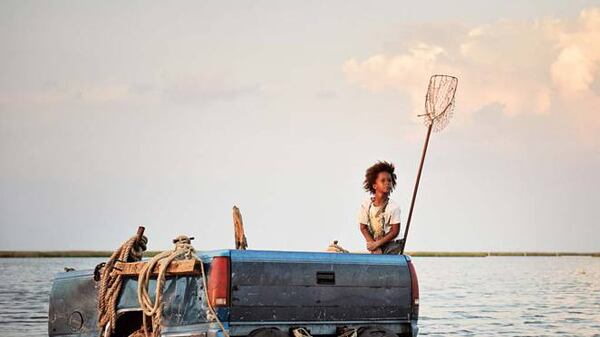Benh Zeitlin, the 29-year-old director of Beasts of the Southern Wild, the 2012 Sundance Film Festival’s most talked-about movie—and winner of the coveted Grand Jury Prize and FIPRESCI Prize at Cannes—is running late. So Quvenzhane Wallis, star of Zeitlin’s film, does what any other 8-year-old girl would do to pass the time—eats a couple of oranges, guzzles a can of Sprite, extols the virtues of Wizards of Waverly Place, and parks herself in front of my laptop computer for a rousing game of Ninja Painter. It’s a far cry from Hushpuppy, her crawfish-eating, vodka-swilling, cardbox box-cave painting character in the film.
And for Zeitlin, tardiness, it seems, has been a blessing in disguise.
After a stint in New York City teaching film at the Grace Church School, followed by a brief sojourn in the Czech Republic working for animator Jan Svankmajer, Zeitlin made his way down to post-Katrina southern Louisiana to shoot the short film "Glory at Sea." The seven-minute, $7,000 film was supposed to take a month but, due to various work stoppages, shooting lasted eight months and the film ended up clocking in at almost 26 minutes.
“By the time I was done with it I knew I was going to stay in Louisiana,” said Zeitlin in an interview with The Daily Beast. “Probably the reason I wanted to do Beasts so much was because I wanted to know why I felt so compelled to stay.”
Meanwhile, Zeitlin’s debut feature, Beasts of the Southern Wild, was supposed to be ready for last year’s Sundance.
“It wasn’t close,” said Zeitlin. “We were, in typical fashion, barreling towards a completely unrealistic, insane goal. We were at the early stages of everything, though. We had no sound design, no color, no visual effects, and no score.”

Beasts centers on Hushpuppy, a 6-year-old girl who, along with her father, Wink (Dwight Henry), lives in “the Bathtub,” the southernmost community in Louisiana. Wink’s tough-love parenting is meant to prepare Hushpuppy for the coming apocalypse, and when he falls ill, nature loses its balance and the polar ice caps melt. The area floods and an army of mythical prehistoric creatures called “auruchs” head straight for the Bathtub. With nowhere to turn, Hushpuppy goes off on a frantic search for her mother, who left the family when her daughter was an infant. The film is a wondrous, visually resplendent fairy tale for post-Katrina America that comes across like a bayou mélange of Mad Max and The Neverending Story, and boasts one of the greatest child performances of all time from newcomer Wallis.
Principal photography on Beasts, shot on location in Louisiana’s Terrebonne Parish, lasted seven weeks, with special effects adding an additional week. The film’s entire cast was made up of locals with no acting training, but naturally the most difficult part to cast was Hushpuppy, the courageous 6-year-old who appears in nearly every scene of the film. Casting directors looked at 3,500 kids ages 6-12 for the part before settling on Quevenzhane, or "Nazie," who was just 5 at the time she auditioned. For Zeitlin, Nazie’s casting dramatically altered the character of Hushpuppy.
“She was always tough, but she was kind of talkative and what was important about the character wasn’t as clear,” said Zeitlin. “When she auditioned the first time, she had this hard stare and this sense of right and wrong. In the callback audition I tried getting her to throw this water bottle at our casting director, and she said, ‘I won’t do that. That’s wrong.’”
“I couldn’t do it!” exclaimed Nazie. “I didn’t even know his name, so I didn’t want to throw [the bottle] at him.”
Zeitlin added: “She had this defiance and such an internal sense of right and wrong. With child actors, they’re always wondering, ‘Is that good?’ And I think Nazie has an internal sense of, ‘That’s good,’ or ‘I just did good.’”
Then came financing. Beasts, which was shot with the help of the film collective COURT 13—named after a Wesleyan squash court that Zeitlin and Co. used to frequent—was, according to Zeitlin, made on a budget of “between $1 million and $2 million,” which came from a variety of sources. A product of the Sundance Screenwriting, Directing, and Producing labs, Beasts was the first film production of Cinereach, a foundation that provides grants for filmmakers. With the exception of a few grants from NHK, Rooftop Films, and the San Francisco Film Society, Cinereach, Zeitlin said, “basically took on the whole film.” Because Cinereach is a nonprofit, Zeitlin had to construct the production of Beasts on a nonprofit model, which is fairly unprecedented.
“Profits are going to go back into other movies, which is pretty incredible,” said Zeitlin. “If the movie does well, the actors and filmmakers have points, but as far as the production company goes, the money is going to get turned over and put into more projects like this one.” He added, “There was no fiscal motivation for production decisions, which allowed us to cast non-actors and do this in the grassroots way that we did.”
One of the film’s crowning achievements is its distinctive, post-apocalyptic feel. The convincing mise en scène was created with “smoke and mirrors,” said Zeitlin. Shots of helicopters and the polar ice caps melting were culled from other footage, and the crew raised real animals, sometimes from just two weeks old, and trained them to be actors in the movie. The scenes where Hushpuppy and Wink’s home is being hit with a terrible storm was accomplished by crew members creating a web of hoses and punching holes in them, creating a dripping effect that came through the house. The film’s dilapidated homes, meanwhile, including shacks submerged in water, were shot on location during a scouting trip by Zeitlin down Louisiana’s Pearl River, so all the scenes of homes submerged under water were 100 percent authentic.
Then there was Wink’s amazing DIY truck-boat. “It was incredibly complicated, but it’s basically a pneumatic barrel system under the truck bed,” said Zeitlin. “That’s actually my truck! It blew up on me a few weeks before filming and while we were watching it going down, we were like, ‘This truck will live on!’ So we took the back of the truck and turned it into the boat, and one of the parade floats is also built from the front of the truck.” He added, “We had this attitude where if we saw something that spoke to us, we’d put it in the movie.”
Beasts of the Southern Wild also features some of the most eye-catching cinematography in recent years, courtesy of director of photography Ben Richardson, who took home the Cinematography Award at Sundance for his efforts. According to Zeitlin, the aesthetics of the camera were very much influenced by documentaries, including those of Les Blank—in particular, Drywood, which was shot in the ’70s in Louisiana.
“We knew the world was going to have this exaggerated quality to it, but we didn’t want to call attention to that because we wanted the audience to experience it the way Hushpuppy does,” said Zeitlin. “Everything was shot documentary-style and reactive. If Nazie was going to pick up her Sprite right now, the cameraman would never know that before she did it, so the cameraman would have to react and follow her.”
Zeitlin’s film, which was acquired by Fox Searchlight immediately after its first press and industry screening, is, at its core, a love letter to the never-say-die attitude of the Katrina-ravaged South.
“There’s really a personal freedom and a celebratory-ness and a humor that’s happening in the face of some pretty dire environmental circumstances down there. I found the resilience and the tenacity addictive,” said Zeitlin. “I still do, and I’m probably going to live there the rest of my life.”
This story was originally published on The Sundance Channel. Check out more film coverage from The Sundance Channel: http://www.sundancechannel.com/sunfiltered/film/.






